
Related
Part 2 of our conversation with award-winning reporter Shane Bauer talking about his recent article, “I Went Behind the Front Lines with the Far-Right Agitators Who Invaded Berkeley.”
Transcript
AMY GOODMAN: This is Democracy Now!, democracynow.org, The War and Peace Report, as we continue with Part 2 of our conversation with the award-winning reporter Shane Bauer. In Berkeley, California, at least 20 people were arrested as fights broke out between white nationalist Trump supporters and anti-fascist protesters during competing rallies this past weekend, on Saturday.
Shane Bauer is an award-winning senior reporter at Mother Jones. He wrote about the protests with an article headlined “I Went Behind the Front Lines with the Far-Right Agitators Who Invaded Berkeley.”
So, talk about going behind the front lines, Shane.
SHANE BAUER: Well, when I heard about this rally, I, you know, of course thought about my time last year undercover with a right-wing militia called the III% United Patriots. I had heard that the Three Percenters were going to have a presence at this rally, so I was interested in kind of spending time not only with them but with the other groups, so—which essentially involved going to one side of a very demarcated situation. I saw that there were militia members there. There were Three Percenters that were, essentially, being kind of controlled and moving in a hierarchical kind of militaristic way. You know, when the kind of leftist protesters would get near them, a commander would give an order to—and they would kind of move into formation to form defensive positions.
AMY GOODMAN: And talk about the other groups that came together and, ultimately, how 20 people were arrested. And a person was knifed?
SHANE BAUER: I don’t actually know anything about somebody being knifed. I did see a man draw a knife at one point and was essentially surrounded by counterprotesters and eventually backed down. The arrests were a mix of arrests for assaults with deadly weapons, which, you know, included sticks and various kind of objects that people were hitting each other with. One of the people arrested was Kyle Chapman, who has become known as Based Stickman, after a rally last month in Berkeley where he hit an antifa protester over the head with a stick.
AMY GOODMAN: What did you think was most striking about the protesters in this case? Have you ever seen a clash like this?
SHANE BAUER: I’ve never seen a clash like this. I mean, this was an extremely violent day. And what really surprised me the most was the kind of mix of people on the pro-Trump side. I mean, you had kind of regular Trump supporters that were supporting Trump for various reasons. People told me that they were there because they saw Trump as a businessman. Some people were there saying that they were there to support the idea of free speech. There were a lot of people with signs referencing obscure “alt-right” memes from the internet, some anti-Semitic signs, and then the more organized groups, like the Proud Boys, which is a group that calls itself a Western chauvinist groups, Identity Europa, which is a white nationalist group, and Three Percenter militias.
AMY GOODMAN: I want to go to Louise Rosealma, the anti-fascist activist who was punched in the face at the Berkeley protest by Nathan Damigo, a former marine who founded the white supremacist organization known as Identity Europa. Louise spoke with KPIX after the protest.
LOUISE ROSEALMA: The next thing I remember was like turning around, and, from the corner of my eye, I saw like the—this fist coming at me. And I didn’t have any time to like—like understand and process what was going on. I just like put my arms up to like kind of push him away as much as I could. And he just totally like threw himself into me. He punched me like right on the bridge of my nose, which—it kind of cut it a little bit, but it’s already kind of healed. But I got thrown down. I’m pretty sure he just ran. He fleed. I got right back up. I was punched twice more by two other people. People kept trying to throw me down, to hit my head on the rocks that were in the planter. And I was—I was really just trying not to get my skull cracked open. But they kept throwing me down. And the last thing that happened was someone came up, and it was crazy, because I made eye contact with him as he was running up to me. And he grabbed me by like my shoulders, like this, and he started kneeing my forehead a bunch of times. But I kind of just tried to struggle away, and I like tried to get him off me. And they all just kind of ran. They fleed. It was like hit-and-runs, and it was over.
REPORTER: Was it all men?
LOUISE ROSEALMA: Yeah, yeah.
AMY GOODMAN: So that’s the anti-fascist protester, whose name is Louise Rosealma. She was punched in the face by Nathan Damigo, a former marine who founded the white supremacist organization known as Identity Europa. Shane Bauer, can you talk about him and this group?
SHANE BAUER: Yeah. Well, I’ve been watching kind of the response around that incident online. I didn’t see the incident myself. But there have been a lot of his supporters that have really been doubling down on him striking her, which, frankly, is a little bit surprising. And she has since said that she’s been facing death threats and has been harassed by people who have—who have gotten her contact—her contact information. And as far as I know, I mean, I didn’t—I don’t know if Nathan Damigo was there by himself or with his supporters, but there were other kind of neo-Nazi groups there. There were people who I overheard discussing the kind of nuances of their brands of white nationalism and even Sieg Heiling.
AMY GOODMAN: You mean doing the Nazi salute.
SHANE BAUER: Doing the Nazi salute, that’s right.
AMY GOODMAN: So, you have Nathan Damigo, who’s a student at Cal State Stanislaus, and one of the people who’s come to his defense is the white nationalist Richard Spencer, who causes so much controversy everywhere he goes to speak?
SHANE BAUER: Right. Yeah, and part of—
AMY GOODMAN: Talk about who they are.
SHANE BAUER: You know, part of what was interesting to me about this demonstration is that, you know, one of the kind of frameworks, aside from, you know, the free speech framework, was a support of Trump. And there were a lot of people there that were identified with the “alt-right.” Richard Spencer has been very critical of Trump lately. He came out against Trump after the Syria bombing. And this rally may be an indication that his standing in that group is diminishing, because a lot of these people that we normally associate with him were out there showing their support for Trump, despite his opposition.
AMY GOODMAN: And can you talk about who Richard Spencer is, just for people who are not familiar?
SHANE BAUER: Richard Spencer kind of became known during the 2016 election as a kind of spokesperson for the so-called alt-right. He is a white nationalist. He believes in what he calls a white ethno-state, which is essentially a nation that is purely made up of white people.
AMY GOODMAN: And the—
SHANE BAUER: And he’s been an avid supporter of Donald Trump and sees Donald Trump as—has seen Donald Trump as somebody who supports his cause, until very recently.
AMY GOODMAN: And Nathan Damigo’s group, Identity Europa, what exactly that means?
SHANE BAUER: It’s very similar. Essentially, there’s a European identity. He talks about not having to apologize that identity. He and Richard Spencer have essentially tried to reclaim identity politics from the left, to use it in a kind of a white supremacist framework, you know, saying that the white identity is important, invaluable, that white people should not be ashamed of their identity, etc.
AMY GOODMAN: Shane, how would you talk about this protest and what you think—how the organizing went behind it, as it went down?
SHANE BAUER: I mean, I am not very familiar with the organizing that went behind the counterprotests. The rally itself, as far as I know, was called for online, which, you know, is—this, I think, is a very new phenomenon, because you have a bunch of disparate groups that essentially only know each other from the internet. And a lot of them, it seemed, were interacting for the first time in real life at this rally. And, you know, the danger of this dynamic, I think, is that each time there has been one of these rallies, starting with the Milo Yiannopoulos talk on Berkeley campus and followed by a free speech—so-called free speech rally from far-right groups in the second rally, they have become more and more violent. There are more and more people that turn out. And it seems to be just a process of escalation.
AMY GOODMAN: And can you talk about the rise of anti-fascist organizing, the people who are coming out to protest the white supremacists and nationalists, and what their strategy is?
SHANE BAUER: Well, anti-fascist organizing has a long history. It’s been pretty active in Europe in recent years, essentially is, you know, made up of anarchists and other far-left groups and activists who see it as imperative to stop, you know, fascists and white nationalist groups from gaining power and from becoming more widespread. So they—when these groups hold rallies or, you know, show up in the public, the anti-fascist activists tend to show up to try to stop them from having a presence.
AMY GOODMAN: Can you talk about the Berkeley mayor issuing the statement saying, “Berkeley values are rooted in the ideas of free speech and peaceful protest. Unfortunately outside groups chose Berkeley as the location for a confrontation with intentions to create violence”? Your comment?
SHANE BAUER: I didn’t see the mayor’s comment myself, but this—this idea of a free speech rally was very contentious. And, you know, the idea that—the way that free speech is being used in this kind of coalition of far-right groups is essentially that, you know, we get to say whatever we want to say. A lot of the people that are advocating for this are people who are openly racist, you know, and it’s more than ironic that they are kind of coopting the same cause as what was essentially a civil rights group in the 1960s on UC Berkeley campus.
AMY GOODMAN: There was a large bang that disrupted the rally. Do you know what this came from?
SHANE BAUER: There were bangs throughout the rallies. It seems like they were coming from M-80s. The first large brawl that I saw was—happened after an M-80 was thrown. It seemed to be thrown from the anti-fascist side onto the right-wing side. And then the—
AMY GOODMAN: You mean a firecracker.
SHANE BAUER: Yes, yeah, a large firecracker. And then, you know, the people from the right-wing side essentially rush across the line and start fighting people. And, you know, it kind of added to this environment of—you know, there were times that it felt like being like in a war zone. I mean, there were kind of explosions of these firecrackers going off that were very loud. There were smoke bombs. Occasionally there was tear gas from police. There were rocks and bottles flying back and forth, and just, you know, just kind of moments of total chaos, of people just, you know, fighting all around.
AMY GOODMAN: You referred to this before, Shane, but the Berkeley police have come under criticism for not stepping in to stop Saturday’s violent demonstrations, the city, the mayor, also coming out in defense of the police, saying if they, quote, “went in more aggressively, more people could’ve gotten hurt. We have to balance how we respond with the goal of trying to keep as many safe as possible.” He went on to say, as we were referring to before, “Outside groups have chosen Berkeley as the location for a violent confrontation.” So, talk about both and what you think needs to happen. Clearly, these demonstrations are going to continue.
SHANE BAUER: Well, it seems like the police have changed their strategy a lot from years past. It, you know, used to be that when there was a demonstration in the Bay Area that turned violent or where property was destroyed, police would come in and round people up and arrest them and remove them from the area. That rarely happens anymore. Now you see police officers filming people. Even when the riot police disappeared, there were men on rooftops filming the violence as it happened. In the police’s statement, they said that they would be reviewing not only their footage, but footage that appeared on social media, to identify people that were committing crimes, so that they can arrest them later. This has happened in relation to past protests, not only in the Bay Area, but elsewhere, where police have come and arrested people after the fact. And, you know, so it seems like that this is kind of a new approach, which is why, you know, you see in these demonstrations people on both sides wearing masks, you know, to kind of protect their identities, because there is inevitably so much filming going on and so much material that ends up online.
AMY GOODMAN: Shane, can you talk about the media coverage of this protest?
SHANE BAUER: Well, a lot of the media coverage that I saw was, you know, coming from elsewhere, from people who were not on the scene. It was framed typically as a pro-Trump versus anti-Trump kind of rally. Some mistakenly called it a Tax Day protest. But, you know, I think, as Natasha Leonard wrote in Esquire magazine, it’s important to understand that the pro- and anti-Trump framework is very thin. You know, Trump was rarely actually mentioned, as far as I heard, in the speeches at this rally. The issues that were coming up were kind of much deeper issues of the far right, like, you know, white nationalism, gun rights, you know, kind of fear of the left somehow taking people’s rights away.
AMY GOODMAN: In the beginning of the first part of the conversation, we talked about the Trump rally being organized by Proud Boys, which describe themselves as “Western chauvinists.” Who are the Proud Boys?
SHANE BAUER: The Proud Boys, as far as I know, you know, have kind of become known on the “alt-right,” you know, which is a scene that has for a long time been something that basically exists on the internet, that is very focused on commentary, on article writing, on kind of making arguments in support of their white nationalist agenda. The Proud Boys are people who come out onto the streets and are often really violent. So, they, you know, are people that are often on the front lines of these kind of clashes that have been happening. There was a far-right writer, Lauren Southern, who has become a kind of a figure in the “alt-right,” who has, you know, said things like rape culture does not exist. She’s said that Black Lives Matter has killed more people than the KKK, which is a, you know, patently false statement. And she was—she was there with Proud Boys as her security, so she was travel—walking around with a group of guys around her at all times.
AMY GOODMAN: You’re covering the anti-fascist organizing, and you’re going undercover in the right. Last year, you wrote about going undercover with a right-wing border militia. You just won a National Magazine Award for best reporting, for going undercover at a private prison. You, yourself, were imprisoned for several years in Iran, one of the three known as, you know, the American hikers, who were imprisoned at Evin Prison, ultimately released. Why have you chosen to go in this direction, after this experience in Iran? And what have you learned?
SHANE BAUER: Well, my time in Iran kind of drew me to reporting on prisons in the United States. Having spent time in solitary confinement, I—in Iran, I was drawn to the use of long-term solitary confinement in the United States. And after reporting on that for Mother Jones, I was kind of drawn deeper and deeper into our prison system, and ultimately decided that the best way to really have a good look inside was to take a job as a prison guard, to spend—you know, to go into a prison day after day, specifically a corporate-run prison. I have also—you know, before Trump’s elected, was interested in the rise of the paramilitary right, which drew me to the militia movement. And, you know, it’s become obvious now that this is a major issue, so it’s definitely something that, you know, I intend to look at going forward. But for the time being, I’m writing a book about private prisons, so that’s kind of my main focus right now.
AMY GOODMAN: Then you have, you know, this other thread going through, from looking at the prisons in California to going undercover in a prison in Louisiana, to going with the border militia, to looking at the right-wing organizations of these prison guards. Can you talk about that in relation to what you saw on the streets of Berkeley?
SHANE BAUER: I mean, I didn’t see any—I don’t know, you know, what the jobs were of people that were out there. But I do think that it’s important to look at the kind of connection between these far-right groups and kind of more official groups. And one of the things that I saw in my undercover work with the III% United Patriots militia is that they were working very closely with the federal Border Patrol. The Border Patrol would tell them where to go to try to find immigrants crossing the border. And, you know, even at this rally, there was at least a sense among people on the right that the police were on their side, whether that was true or not. A lot of these guys, you know, have military experience. One of the groups that was there was the Oath Keepers, which is a kind of group of veterans that have a kind of fundamentalist belief in the Constitution and often will show up at protests to—you know, sometimes with an armed presence.
AMY GOODMAN: And finally, you’ve been following these different groups and also going into the prisons for a few years now, since you were released from prison in Iran. Do you see a change under the Trump administration?
SHANE BAUER: Oh, absolutely. I mean, I think that what we’re dealing with now is something that is very new. I mean, even the militia movement that I wrote about just last year, it was—had grown a lot under Obama, but it didn’t have a kind of public presence like the far right does now. You know, I noticed myself, like I’ve heard a lot of people have, that the day after Trump was elected, I started getting comments in my Twitter feed from people whose bios said that they were members of the KKK or various neo-Nazi groups. This has become normal. I mean, this is something that many journalists and kind of people that have more public profiles that write about this stuff deal with day in and day out. And, you know, it can become very aggressive and dangerous. This is apparently what’s happening with the woman that was punched by Nathan Damigo. She says that she’s getting bombarded by neo-Nazi groups now, you know, online and through other venues.
AMY GOODMAN: Since you mentioned her, I wanted to turn back to Louise Rosealma, the anti-fascist activist who was punched in the face, as you said, by Nathan Damigo, the former marine who founded the white supremacist group known as Identity Europa.
LOUISE ROSEALMA: Since my face was caught on camera, I was somehow identified like almost immediately. And from probably like three hours after, from what I saw, I was getting bombard—like it started with a bombardment of harassment and death threats and like just rape threats.
AMY GOODMAN: That was Louise Rosealma speaking on the IGD podcast. Shane, the threats?
SHANE BAUER: I mean, she’s not—she’s not the only one that’s been dealing with this stuff. I know that there’s a woman now who is suing the—I believe it’s the founder of the far-right nationalist—a far-right nationalist website, for sending, you know, what she called a troll storm against her. She was facing death threats and rape threats constantly. So that there’s, you know, this kind of new dynamic that is emerging that people are trying to figure out how to deal with and how to stop, that is, you know, kind of a—exists very much on the internet but comes out into people’s real lives. And, you know, a really common tactic with these groups is that they’ll do what is called doxing, where they find a target, and they dig up their home addresses, phone numbers, identifying information and put it out in the public for anybody who wants to come after and harass them.
AMY GOODMAN: Does Breitbart fit into this picture at all? The online media outlet that Steve Bannon was the head of, now at the White House—who knows if he’ll be staying at the White House or going back to Breitbart? But where does it fit into this spectrum?
SHANE BAUER: Well, Breitbart essentially positioned itself during the 2016 election as a platform for the so-called alt-right, you know, which is a kind of general umbrella of white nationalist groups. Steve Bannon was the head of Breitbart and, you know, has since entered the highest levels of power, which, you know, to many on the “alt-right,” seemed to be a signal that they actually had influence in the White House and over the president.
AMY GOODMAN: Is there anything else you want to add about what happened this weekend or the kind of trends that you’re seeing today, Shane?
SHANE BAUER: I mean, I think that we’re seeing a rising conflict in this country that is not just theoretical conflict, it’s not just a conflict of ideas and persuasion, it’s becoming an actual battle. You know, Berkeley has kind of become a locus for this kind of physical battle over—you know, over the clash between the right and left. And, you know, it’s not always just an issue of people getting punched and kicked. I mean, we—there was a protester in Seattle that was shot, an anti-fascist protester that was shot, at a protest against Milo Yiannopoulos. I think a lot of people are becoming concerned that these clashes are only going to escalate and that there are going to be some very serious injuries coming.
AMY GOODMAN: Well, Shane Bauer, I want to thank you for being with us, award-winning senior reporter at Mother Jones. Your most recent piece, we’ll link to, “I Went Behind the Front Lines with the Far-Right Agitators Who Invaded Berkeley.” Shane is also co-author of the memoir A Sliver of Light: Three Americans Imprisoned in Iran. He also just won the National Magazine Award for going undercover in a private prison in Louisiana.
This is Democracy Now! To see Part 1 of our conversation with Shane, go to democracynow.org. I’m Amy Goodman. Thanks for joining us.

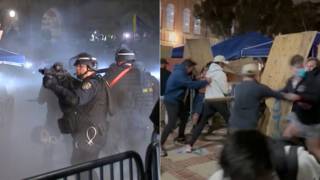
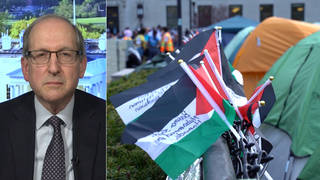
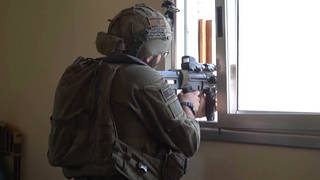
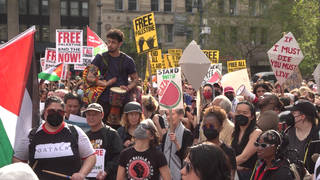





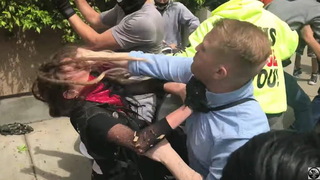
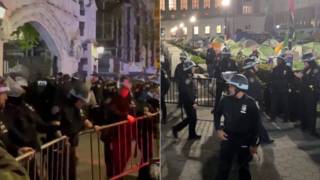
Media Options